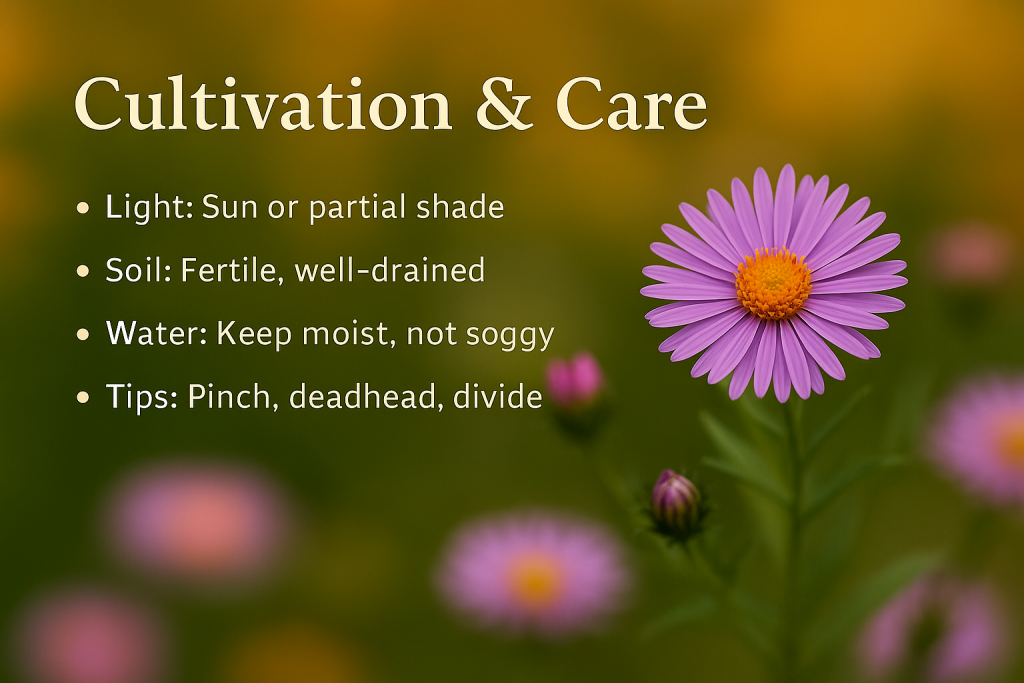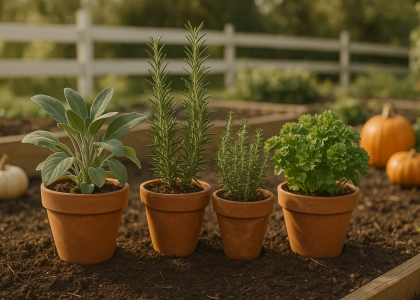When most flowers fade in late summer, asters take the stage with their starry blossoms. These resilient perennials light up autumn borders, sustain pollinators, and carry a legacy of healing traditions across cultures.
Discover how asters can brighten your garden, soothe seasonal ailments, and stand as a symbol of resilience.

Botanical Overview
- Family: Asteraceae (Daisy family)
- Scientific Name: Aster spp., Symphyotrichum spp.
- Plant Type: Herbaceous perennial
- Bloom Time: August – October
- USDA Hardiness Zones: 3–8
Appearance & Garden Value
- Star-shaped, daisy-like flowers in purple, lavender, blue, pink, and white with golden centers.
- Provide vital late-season nectar for bees, butterflies, and other pollinators.
- Often called the “farewell flowers” of summer, symbolizing patience, wisdom, and hope.
- Excellent for cottage gardens, mixed borders, and pollinator habitats.
Cultivation & Care
- Light: Full sun preferred; tolerates partial shade.
- Soil: Fertile, well-drained, slightly acidic to neutral.
- Watering: Keep soil evenly moist, but avoid waterlogging.
- Tips:
- Pinch stems in early summer for bushier plants.
- Deadhead blooms to extend flowering.
- Divide clumps every 2–3 years to prevent overcrowding.

Medicinal & Health Benefits
- Native American uses: Roots brewed for lung ailments, fevers, and colds.
- Contains flavonoids, saponins, and terpenes with proven anti-inflammatory and expectorant properties.
Potential Drawbacks
- May cause allergic reactions in individuals sensitive to daisies or ragweed.
- Some species can self-seed aggressively if unmanaged.
- Overcrowding increases risk of powdery mildew.
Common Pests & Diseases
- Powdery Mildew → Improve airflow, avoid overhead watering, use resistant cultivars.
- Aphids → Control with neem oil or insecticidal soap.
- Rust → Remove infected foliage; rotate planting sites.
Regional Care Tips
- Cold Climates (Zones 3–5): Choose hardy cultivars like Symphyotrichum novae-angliae. Apply mulch before frost.
- Temperate Climates (Zones 6–8): Ensure proper spacing and airflow to prevent mildew.
- Hot & Dry Climates (Zones 8–9): Provide afternoon shade and increase deep watering during heat waves.
FAQ
Q: Do asters spread easily?
A: Yes. Some varieties self-seed or spread by rhizomes. Divide clumps every few years to maintain control.
Q: How do I prevent powdery mildew?
A: Space plants properly, water at soil level, and choose resistant cultivars.
Q: Are asters safe for pets?
A: Generally, yes. Asters are considered non-toxic to cats and dogs, making them family-friendly garden plants.
Asters are not just ornamental — they are autumn’s final gift of color and hope. They nourish pollinators, support respiratory health in traditional medicine, and remind us of resilience in times of transition.
CTA
👉 Save this guide for your fall gardening plans.
👉 Follow Greenmuse for more healing plant wisdom.





